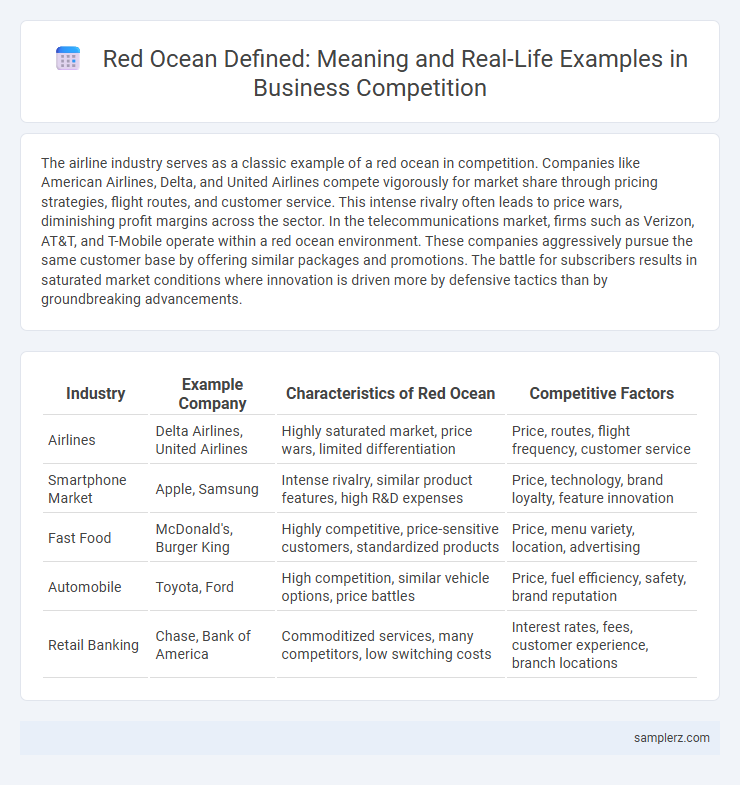The airline industry serves as a classic example of a red ocean in competition. Companies like American Airlines, Delta, and United Airlines compete vigorously for market share through pricing strategies, flight routes, and customer service. This intense rivalry often leads to price wars, diminishing profit margins across the sector. In the telecommunications market, firms such as Verizon, AT&T, and T-Mobile operate within a red ocean environment. These companies aggressively pursue the same customer base by offering similar packages and promotions. The battle for subscribers results in saturated market conditions where innovation is driven more by defensive tactics than by groundbreaking advancements.
Table of Comparison
| Industry | Example Company | Characteristics of Red Ocean | Competitive Factors |
|---|---|---|---|
| Airlines | Delta Airlines, United Airlines | Highly saturated market, price wars, limited differentiation | Price, routes, flight frequency, customer service |
| Smartphone Market | Apple, Samsung | Intense rivalry, similar product features, high R&D expenses | Price, technology, brand loyalty, feature innovation |
| Fast Food | McDonald's, Burger King | Highly competitive, price-sensitive customers, standardized products | Price, menu variety, location, advertising |
| Automobile | Toyota, Ford | High competition, similar vehicle options, price battles | Price, fuel efficiency, safety, brand reputation |
| Retail Banking | Chase, Bank of America | Commoditized services, many competitors, low switching costs | Interest rates, fees, customer experience, branch locations |
Defining Red Ocean Strategy in Business Competition
Red Ocean Strategy in business competition refers to markets saturated with fierce rivalry where companies compete for limited demand, often leading to price wars and reduced profitability. A prime example is the global airline industry, where firms battle over established routes and customers with minimal differentiation, resulting in cutthroat pricing and shrinking margins. Businesses in red oceans focus on outperforming rivals rather than creating new market space, highlighting the challenge of gaining competitive advantage within existing industries.
Classic Red Ocean Market Examples
Classic red ocean market examples include the airline industry, where intense rivalry drives price wars and reduced profit margins. The smartphone market also exemplifies a red ocean, with major brands competing fiercely on features and pricing. These industries demonstrate saturated markets where companies battle to outperform rivals in existing demand.
Case Study: Cola Wars between Coca-Cola and Pepsi
The Cola Wars between Coca-Cola and Pepsi exemplify a red ocean market characterized by intense competition in the carbonated soft drink industry, where both companies aggressively vie for market share through pricing strategies and heavy advertising. This saturated market limits growth opportunities, compelling Coca-Cola and Pepsi to focus on differentiating product features and promotional campaigns to outmaneuver each other. The rivalry demonstrates the challenges of competing in a well-defined, high-competition space with minimal room for innovation outside existing market boundaries.
Fast Food Industry: McDonald’s vs. Burger King
McDonald's and Burger King compete in the fast food industry's red ocean by targeting similar burger-centric menus and price-conscious customers, intensifying rivalry through heavy advertising and promotional discounts. The saturated market forces both chains to continuously innovate with limited menu differentiation and aggressive store expansions. This fierce competition results in thin profit margins and significant marketing expenditures to capture market share.
Smartphone Battles: Apple vs. Samsung
The smartphone market exemplifies a red ocean competition where Apple and Samsung fiercely compete for market share with similar high-end features and pricing strategies. Both giants heavily invest in incremental innovations, aggressive marketing, and extensive distribution networks to attract overlapping customer segments. This intense rivalry limits profit margins and stifles differentiation, driving companies to outpace each other in saturated industry conditions.
Retail Price Wars: Walmart vs. Target
Walmart and Target engage in intense retail price wars, exemplifying a red ocean competitive strategy where both companies aggressively lower prices to capture market share in the highly saturated retail industry. This rivalry forces reduced profit margins and limits differentiation as both retailers offer similar grocery and household products. The fierce pricing competition illustrates how businesses in red oceans compete primarily on price within existing demand rather than creating new market space.
Airline Industry Competition: American vs. Delta
The airline industry exemplifies a red ocean market, with American Airlines and Delta Air Lines fiercely competing for the same customer base through price wars, route overlaps, and similar service offerings. Both carriers invest heavily in marketing, loyalty programs, and operational efficiency to capture market share in major domestic and international routes. This intense rivalry drives profits down and limits differentiation, reflecting classic red ocean competitive dynamics.
Automobile Industry Showdowns: Ford vs. Chevrolet
The automobile industry exemplifies a red ocean with intense competition between Ford and Chevrolet, both vying for market dominance through aggressive pricing and extensive marketing campaigns. Each brand targets similar customer segments, leading to overlapping product lines and high rivalry within the mid-size pickup truck and SUV markets. This competition results in slim profit margins and continuous innovation to capture consumer loyalty and increase market share.
Streaming Service Rivalry: Netflix vs. Amazon Prime
The streaming service rivalry between Netflix and Amazon Prime exemplifies a red ocean market, where both companies compete fiercely over existing customer bases and content libraries. Intense competition drives aggressive investments in original programming and pricing strategies to capture market share. This saturated environment leads to minimal differentiation and shrinking profit margins as both giants vie for dominance.
Lessons Learned from Red Ocean Competitive Examples
Competing in a red ocean market often leads to intense rivalry and shrinking profit margins as companies vie for the same customer base, shown by the smartphone industry's aggressive feature wars among Apple, Samsung, and Huawei. Lessons learned include the critical importance of differentiation through unique value propositions rather than price-cutting, and the need for continuous innovation to avoid commoditization. Businesses must analyze competitor strategies deeply and identify unmet customer needs to carve out a niche, mitigating the risk of eroding profits in overcrowded markets.

example of red ocean in competition Infographic
 samplerz.com
samplerz.com